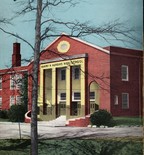
Harding High School

Harding High History
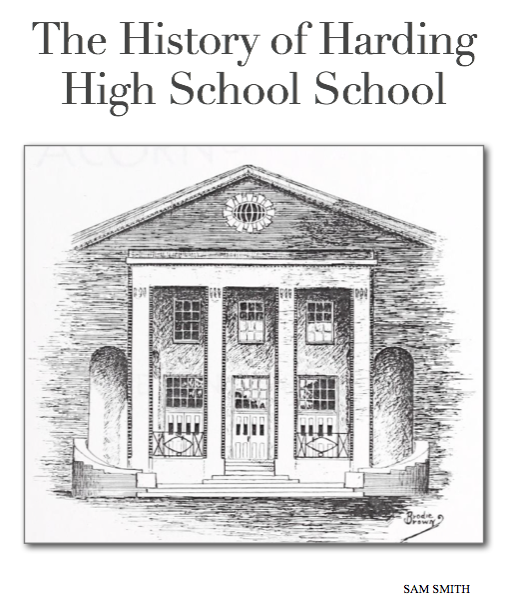
Contents
Chapter 1 Harry P. Harding
Chapter 2 The New School Opens
Chapter 3 The Late Thirties
Chapter 4 The Early Forties
Chapter 5 The War Years
Chapter 6 The Late Forties
Chapter 7 The Early Fifties
Chapter 8 The Mid Fifties
Chapter 9 The Late Fifties
Chapter 10 The Closing Years
Chapter 1 Harry P. Harding
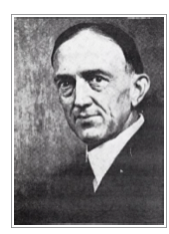 The history of Harding High School starts with the man for whom it was named, Harry Patrick Harding. Harry P. Harding, as he was known most of his life, was born on August 14, 1874, in Aurora, a small town on the banks of South Creek, a tributary of the Pamlico River in eastern North Carolina. Harry was one of eight children born to Confederate Major Henry Harding and his wife, Susan Elizabeth Sugg. His father, Major Harding, served in the 61st North Carolina Infantry from 1862 through 1864. Returning from the war, he went to work on the farm and in 1866 was elected to the state House of Representatives. In 1885 Major Henry Harding moved the family to Greenville, N. C., where he had accepted a position as a teacher, and later as the Superintendent of Schools.
The history of Harding High School starts with the man for whom it was named, Harry Patrick Harding. Harry P. Harding, as he was known most of his life, was born on August 14, 1874, in Aurora, a small town on the banks of South Creek, a tributary of the Pamlico River in eastern North Carolina. Harry was one of eight children born to Confederate Major Henry Harding and his wife, Susan Elizabeth Sugg. His father, Major Harding, served in the 61st North Carolina Infantry from 1862 through 1864. Returning from the war, he went to work on the farm and in 1866 was elected to the state House of Representatives. In 1885 Major Henry Harding moved the family to Greenville, N. C., where he had accepted a position as a teacher, and later as the Superintendent of Schools.
Upon graduation from the Greenville Male Academy in Greenville, Harry entered the University of North Carolina at Chapel Hill where he was elected Phi Beta Kappa and received his Bachelor of Arts degree. After UNC he accepted his first position in education at New Bern High School where he became Principal. In 1904 the superintendent of schools in Charlotte, Alexander Graham, recruited Harry to the position of a graded school in Charlotte. He was soon elevated to assistant superintendent and in 1913 succeeded Graham as Superintendent of Charlotte Schools.
In 1926 when Harding was walking from Fairview school to Zeb Vance through Irwin Park he noticed a plot of ground between Irwin Creek and Elmwood Cemetery that he thought would be a good location for a new school to serve the Fourth Ward and the western section of the city. He obtained approval from the school board to purchase the fifteen acres of land for $45,000.
However, before a school could be built on the site the Depression hit and the state legislature annulled the charter that allowed cities to levy special taxes for schools. This resulted in a 61% budget cut for the school district and the elimination of the 12th grade. When the legislature restored the charter Harry P. Harding worked to have Charlotte voters restore the special levy but the referendum failed. Harding then approached Charlotte businessmen to win their support for another vote and he was successful in getting it approved. As a result, after almost a decade of the fifteen acres lying vacant, work began on building a new combination junior and senior high school just off West 5th Street.
Chapter 2 The New School Opens
The new building consisting of fourteen classrooms, an auditorium, and two offices was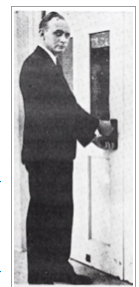 completed and ready for students in September of 1935. The cost of construction was approximately $100,000. Mr. James R. Hawkins was assigned as the first principal. Born in Athens, Ohio, on October 12, 1901, He graduated from Ohio University, Athens, and began his teaching career at Mt. Airy, N. C., High School. He then taught at Borden High School in Salisbury, and in 1928 he became principal of Albemarle High School. In 1932 he moved to Charlotte to accept the position of Dean of Boys and assistant to Principal Elmer Garimger at Central High. In 1935 he was chosen to be the first principal of Harding High by Superintendent Harding who said he chose Mr. Hawkins because of his ability, training and personality.
completed and ready for students in September of 1935. The cost of construction was approximately $100,000. Mr. James R. Hawkins was assigned as the first principal. Born in Athens, Ohio, on October 12, 1901, He graduated from Ohio University, Athens, and began his teaching career at Mt. Airy, N. C., High School. He then taught at Borden High School in Salisbury, and in 1928 he became principal of Albemarle High School. In 1932 he moved to Charlotte to accept the position of Dean of Boys and assistant to Principal Elmer Garimger at Central High. In 1935 he was chosen to be the first principal of Harding High by Superintendent Harding who said he chose Mr. Hawkins because of his ability, training and personality.
When the school opened it had no seats in the Auditorium, no gym, no cafeteria and no place to put the few reference books of the school since their was no library. Irwin Ave. had not yet been extended to the school. Auditorium seats were installed in October and the construction of the Irwin Ave. extension was completed in December. The first P. T. A. was formed and its initial meeting was held on October 13th. They voted to name the school for Harry P. Harding, the Charlotte school superintendent and their recommendation was approved by the P. T. A.s of all of the elementary feeder schools. Mr. Harding resisted because he thought it was inappropriate to name a school for a living superintendent. The P. T. A.s prevailed and the school board approved naming the school Harry P. Harding High School.
Also in 1935 a faculty of fourteen was employed at Harding, including Miss Flora Mae Watson, Miss Rebecca Henderson, Mrs. Willie Shore, Mrs. Lois Roach, Miss Sallie Sandifer, Mrs. Lois Summerville, and Mrs. Mary Sawyer. In its first year the school consisted of the seventh grade through the tenth. The twelfth grade had been dropped at all schools by the action of the state legislature as a cost cutting measure during the depression. Eleventh graders in the district were allowed to attend their previous school.
Mr. H. H. Powell, who was the science and biology teacher, organized the schools first basketball team in January 1936. Mr. Powell played three sports at Westminster College in Missouri. He played professional baseball for one year in a class three western league. He had an outstanding record coaching high school basketball where his team at Harrisburg, Va., won the state championship. In his first year at Harding he also coached track at Central. In May of 1956 baseball got underway with Mr. Powell as coach
Miss Flora Mae Watson, the mathematics teacher, organized the first girls’ softball team in April of 1936.
In June the school published its first annual with the name Acorn and contained the following paragraph: “During our vacation months and in the years to come let us remember our motto of growth and our desire to become like the sturdy oak, and do all in our power to make Harding High a full-fledged junior-senior high school”. The motto was “Tall oaks from little acorns grow”’. The annual was dedicated to Harry P. Harding.
Chapter 3 The Late Thirties
The fall of 1936 brought many additions to Harding High School. Most importantly, an eleventh grade was added. This resulted in a faculty increase to seventeen including the addition of Miss Alice Batten teaching mathematics and Mrs. Gertrude Giles teaching Commercial classes.
In November of 1936 Charlotte voters approved a bond issue that included funds to build additional class rooms and a gymnasium for Harding. The total allowed was $121,000 for buildings and $10,625 for equipment.
It was also a year of adding many school organizations and clubs, including the Department of Physical Education, Honor Society, Student Council, Public Speaking Club, and junior and senior Drama Clubs. Emphasis was placed on music with the formation of an orchestra, band, chorus, and Girls Glee Club.
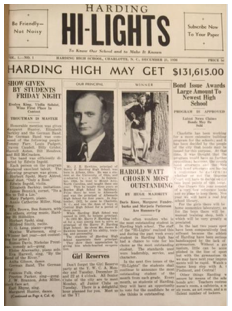 A new publication was added, the Harding HI-Lights, (it was spelled Lights instead of the later Lites). Also, the 1937 Acorn was published with an expanded format and was dedicated to Principal James R. Hawkins in recognition and appreciation of his excellent work in the formation of Harding. (The picture at the side is the front page of the first edition of the Hi-Lights)
A new publication was added, the Harding HI-Lights, (it was spelled Lights instead of the later Lites). Also, the 1937 Acorn was published with an expanded format and was dedicated to Principal James R. Hawkins in recognition and appreciation of his excellent work in the formation of Harding. (The picture at the side is the front page of the first edition of the Hi-Lights)
Beginning the fall of 1937 Harding now had a twelfth grade so it finally had real seniors with thirty-six students in the first Senior Class. Reflecting this addition the staff had grown to twenty-three, including Mrs. Myrtis Mackey teaching mathematics and Mr. Oliver Cook directing the band. Mr. Cook had recently graduated from Elon College where he was in the top three academically.
Seven new subjects were added to the school curriculum including journalism, mechanical drawing, general office practice, bookkeeping, shorthand, and Bible.
The big news in April was the completion of an expansion of the original facility. This provided space for a new gymnasium, cafeteria, library, science labs and a shop. Also construction began on a new athletic field with most of the construction costs provide by the Works Progress Administration (WPA). Harry P. Harding, now known as uncle Harry to the students, awarded the school an new public address system for the auditorium. The system consisted of “two speakers and a modern Webster microphone with enough power to carry the weakest voice to the back of of a large auditorium.”
As Christmas, 1937, approached, the Hi-Lights carried the teachers requests for Santa. Miss Sandifer asked for “a great big kiddie-car so I can take my European History class to Europe and show the natives how to make history so I can give stiff tests to keep all my students from making A’s.”
The Acorn continued to expand with the addition of Superlatives and it was dedicated to Miss Edna Triplett who guided the publication of the first Acorn.
In June of 1938, the school held its first graduation ceremony. In recognition of this the Acorn included the following class poem written by Martha McBroom:
Though the end of these years brings the parting,
And now we must say our good-byes.
We know we shall miss you, dear Harding,
And recall you with tears in our eyes.
The Acorn was dedicated to Est Mademoiselle Henderson (Miss Rebecca Henderson, a foreign language teacher).
With the opening of a new year at Harding in the fall of 1938, the senior class had almost tripled with 64 new seniors forming the Class of 1939 and the faculty had grown to twenty-six.
A new football season was launched with Harding, now led by new coach Marvin Ray, winning only one game, tying one and losing five. The basketball team, now coached by Paul Edwards, finished with a much better result, winning fourteen of their twenty-two games. They particularly enjoyed winning both games they played against Charlotte’s Tech High School.
Again, at Christmas time, the High-Lights carried a list of teacher’s wishes from Santa. Miss Watson asked for the following: “As I do enjoy talking so much I would like to have a loud speaker to use should I lose my voice again. I have some sweet pupils too, that I want remember. Leave for them a flint gun and some ‘thinky' fluid to spray them with so they may absorb math with no effort on their part. But, if I have asked for too much, cancel their part of the order, for I want most of all a blanket of snow on Christmas Day.” Wonder what her students were wishing for?
Chapter 4 The Early Forties
In the fall of 1939 Harding had grown to a student body of approximately 900 students. The Senior Class totaled seventy-four and the faculty increased to twenty-eight with the addition of Emily Carr teaching Home Economics and Ruth Yelvington teaching Foreign Languages. Oliver Cook who was the Band Director took on the additional position of directing the orchestra. With this growth thirty-five students qualified for the Senior High Honor Society.
The boys’ athletic teams were gradually taking on stiffer competition. In spite of this the football team with only sixteen players won six games and lost only one. The basketball team had a very tough schedule that included Albemarle, Rock Hill, Greenville Parker, the Davidson College Freshman, a team from Pittsburgh, Pennsylvania, and two games with Central (the first time any Harding team played their cross-town rival). This schedule resulted in seven wins and fourteen losses. Another highlight of the year was the formation of the Girls Athletic Club.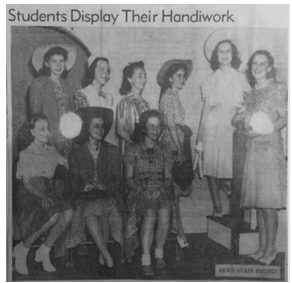
The P. T. A. sponsored an open meeting and asked the girls in the Home Economics class to demonstrate their abilities as dressmakers. The girls responded in period fashions as displayed in the side picture.
The month before the end of the school year the band left on buses for a major trip to participate in a National Band Contest in west Palm Beach, Florida. The band scored well in the competition after having to rehearse in the hotel lobby They returned to Charlotte on a special Seaboard Railway train.
As they prepared for graduation the Class of 1940 celebrated the Junior - Senior Banquet held at the Efird’s Dining room. Their annual was dedicated to Miss Flora Mae Watson.
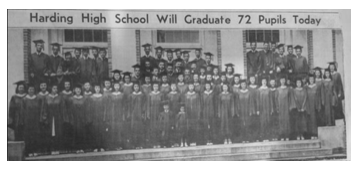 At graduation in June of 1940, seventy-two seniors donned their caps and gowns and heard the commencement address delivered by Dr. Harold D. Meyer of the University of North Carolina. The picture of the graduates was made on the steps of the Harding Auditorium.
At graduation in June of 1940, seventy-two seniors donned their caps and gowns and heard the commencement address delivered by Dr. Harold D. Meyer of the University of North Carolina. The picture of the graduates was made on the steps of the Harding Auditorium.
The fall of 1940 brought the Class of 1941 to the forefront, as they would be the first class to attend Harding for the full six years having entered as the first seventh grade in 1935. With the Senior Class now numbering one hundred eleven, the school had gotten large enough to require the formation of a Traffic Force and for the first time a Debate Club was added.
With the addition of Mrs. Eugenia Christman teaching Civics and Miss Cornelia Nixon teaching Seventh Grade the faculty now numbered forty-one. Miss Nixon would become one of the most popular teachers at the school.
A severe flu epidemic hit Charlotte in December and as a result the students got an additional two weeks vacation during the Christmas season.
The football team continued adding tougher opponents. In a season that included Rock Hill, Fayetteville, Salisbury, Florence, Albemarle, and Central the team won three games and lost six. A 37 – 0 loss to Central, in the first football game the two schools played against each other, launched what would become one of the biggest rivalries in Charlotte high school sports.
At the close of the year the Class of 1941 dedicated the Acorn to Mrs. Myrtis Mackey, a graduate of Coker College, who came to Harding as a 7th grade math teacher after teaching at Derita.
Chapter 5 The War Years
For the first time the size of the Senior Class diminished from the previous year. What began as a seventh grade class of 175 students ended with only 85 graduates in the Class of 1942.
With the country now at war most of the activities of the class had a strong patriotic theme. The program for the Junior-Senior Banquet was in the shape of the United States and the speaker was Mrs. Willie Shore who spoke on the topic of “Democracy Gems”. The Band was featured in the Shrine Bowl parade and also played at the Texas Tech vs. Wake Forest football game, and the Davidson vs. Duke University game. The band director, Oliver Cook, had also assumed the direction of the school choir.
The 1942 Acorn was dedicated to a very interesting faculty member, Mr. Richard Tewkesbury. Mr. Tewkesbury had an interest in the plans to build a Pan American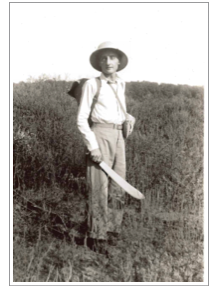 Highway into Central America. The jungles and inhabitants of the Darien Jungle of Panama were viewed as barriers to the construction of the highway. So he decided to use his vacation time during the summers of 1939 and 1940 to take two expeditions through the Darien Jungle to prove that they would not be obstacles. On his first trek he ventured forth alone into the swaps and jungles, sleeping in the open, eating bananas and drinking milk from coconuts. After covering half of the Gap he emerged sick from malaria and weighing only 99 pounds. The next summer, at the urging of the Pan American Union, he returned to the Gap and completed his trek. Mr. Tewkesbury was credited as being one of the first non-native to trek through the Darien Isthmus and come out alive. For his efforts he received a commendation from the Pan American Congress. In 1942 Mr. Tewkesbury’s adventures were published in a comic book, “True Comics”, in a story titled "Jungle Adventurer".
Highway into Central America. The jungles and inhabitants of the Darien Jungle of Panama were viewed as barriers to the construction of the highway. So he decided to use his vacation time during the summers of 1939 and 1940 to take two expeditions through the Darien Jungle to prove that they would not be obstacles. On his first trek he ventured forth alone into the swaps and jungles, sleeping in the open, eating bananas and drinking milk from coconuts. After covering half of the Gap he emerged sick from malaria and weighing only 99 pounds. The next summer, at the urging of the Pan American Union, he returned to the Gap and completed his trek. Mr. Tewkesbury was credited as being one of the first non-native to trek through the Darien Isthmus and come out alive. For his efforts he received a commendation from the Pan American Congress. In 1942 Mr. Tewkesbury’s adventures were published in a comic book, “True Comics”, in a story titled "Jungle Adventurer".
“Tooks”, as he was known to students was only 5’3” tall and weighed just 112 pounds. After his crossing of the Darien Jungle he appeared on “We the People”, a nation-wide radio program hosted by Gabriel Heatter. He had many other travel related adventures including climbing Mt. Kilimanjaro in Africa, traveling the length of the Amazon River, and traveling around the world six times. Time magazine described him as “mild, puny, deep-voiced and bashful with peanut-sized biceps, but he is also lion-hearted, stubborn, iron-nerved, grimly determined and a hero.” A movie about the Columbian jungle contains the following dialogue: “Before he can become a warrior, a man has to leave everything behind and go into the jungle guided only by his dreams.” Richard Tewkesbury certainly proved that he was a warrior as he was realizing his big dream.
Today the Pan American highway stretches from Cape Horn, Chile, to Alaskawith one small gap in Panama, the Darien Gap. Travel advisories say, “Don’t go there”.
When the Class of 1943 returned to school in the fall of 1942, the war in Europe and the Pacific was still being fought and the draft became an issue for many male seniors. A special meeting of the senior boys was held and Mr. Hawkins explained that diplomas would be awarded to any senior boy who was drafted or enlisted after successfully completing his first semester’s work. At the time the draft board was not drafting boys who had begun their second semester work, however, many Harding male students of draft age had already joined the service.
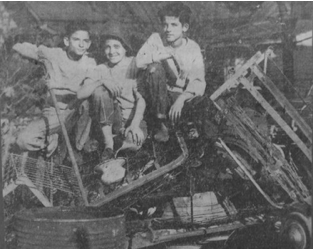
The 1943 Acorn included an ad encouraging the purchase of war bonds and stamps as a way for everyone to participate in the effort. The Harding students supported the war effort in some very tangible ways, by collecting 50,000 pounds of scap metal, as shown at left), by selling war stamps as encouraged by the ad in the Acorn, and by providing 900 christmas gifts for soldiers stationed at Charlotte’s Morris Field.
Harding connected to those in the service in another way, through the game of Basketball.
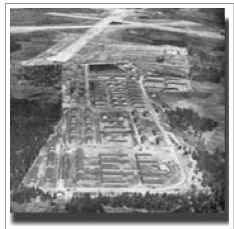 In 1941 the Army Air Corps built a small airstrip with two runways on the west side of Charlotte. In 1942 the airstrip was named Morris Field and several Army Air Corps units were stationed there. During the 1943 basketball season Harding played two games against Morris Field, losing the first by a score of 40–52. In the second game Harding won 52–26, probably reflecting the fact that many of the young airmen were transferred to the Pacific Theater to battle the Japanese.
In 1941 the Army Air Corps built a small airstrip with two runways on the west side of Charlotte. In 1942 the airstrip was named Morris Field and several Army Air Corps units were stationed there. During the 1943 basketball season Harding played two games against Morris Field, losing the first by a score of 40–52. In the second game Harding won 52–26, probably reflecting the fact that many of the young airmen were transferred to the Pacific Theater to battle the Japanese.
The Air Corps vacated Morris Field in 1946 and the City Council bought the rights to the airstrip, which became the precursor to Charlotte’s Douglas International Airport.
The 1943 Harding basketball team had a successful year winning twelve of sixteen games, and by beating both Central and Tech twice was declared the City Champs. In other sports a girls’ basketball team was formed and the football team recorded a season of three wins against five losses.
At the close of the school year the Acorn was dedicated to Miss Alice Batten who was serving as the faculty advisor to the school newspaper, which was briefly renamed “The Hustler”.
The 1944 Acorn opened with the following dedication:
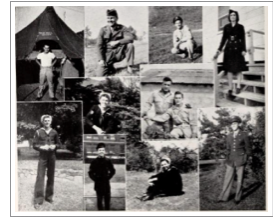
“We remember with pride the boys who have attended Harding and who are now serving in the armed forces of our nation. In our hearts is the deepest gratitude for the sacrifices which they are making that tomorrow we may enjoy life in a never-ending peace. For these boys, fighting for a nation ‘conceived in liberty and dedicated to the proposition that all men are created equal’, the Senior Class of Harding High School dedicates the 1944 Acorn."
Even during the war years the students of Harding continued the normal activities of a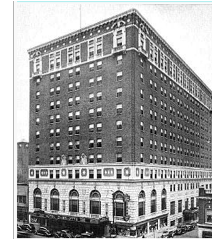 typical high school. These included a May Day dance, many club activities, and a full sports program. The Class of 1944 was entertained at a Junior-Senior banquet held at Hotel Charlotte, a hotel with a rich history. The hotel opened in 1924 and was eventually listed on the National Register of Historic Places. It closed in 1973 and was imploded in 1988. The implosion received national attention because it was used by famous illusionist David Copperfield as the setting for his escape in a TV special titled “The Explosive Encounter.”
typical high school. These included a May Day dance, many club activities, and a full sports program. The Class of 1944 was entertained at a Junior-Senior banquet held at Hotel Charlotte, a hotel with a rich history. The hotel opened in 1924 and was eventually listed on the National Register of Historic Places. It closed in 1973 and was imploded in 1988. The implosion received national attention because it was used by famous illusionist David Copperfield as the setting for his escape in a TV special titled “The Explosive Encounter.”
The faculty now included two new members that would be remembered by the students for years to come: Ms. Lettie Smith teaching Commercial Studies and Ms. Mary MacKorell teaching Bible classes.
As the Class of 1945 entered the school year in the fall of 1944, the war was still being fought in Europe and the South Pacific. The class would be remembered as the "war class" of Harding since they entered the seventh grade in 1939 when hostilities broke out in Europe and would graduate the year the allied troops would bring a victorious conclusion to the fighting. Their edition of the Acorn included the following paragraph in the Class History:
“Thus, we the 1945 Class have travelled the long road. Beginning in the first skirmishes of battle and ending with American armies marching on centers of hate and dictatorship, we spent six important years in Harding High School. We the ‘war class’ remember with pride.”
Throughout the war years the faculty members were able to ensure that the students experienced high school in the same manner as that of normal years. Evidence of 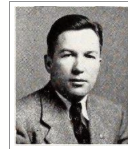 this can be seen in the dedication of the 1945 Acorn, “To Oliver Cook, the man who filled Harding with song.” The Choir presented a Christmas program to a full house at the First Methodist Church. More clubs were added to broaden the high school experience, including the Imperatores and Debate Clubs. The sports programs continued to grow with the addition of E. P. Faulkner as the basketball coach. Faulkner had previously coached at Bessemer City High School.
this can be seen in the dedication of the 1945 Acorn, “To Oliver Cook, the man who filled Harding with song.” The Choir presented a Christmas program to a full house at the First Methodist Church. More clubs were added to broaden the high school experience, including the Imperatores and Debate Clubs. The sports programs continued to grow with the addition of E. P. Faulkner as the basketball coach. Faulkner had previously coached at Bessemer City High School.
The Senior Class had grown to 112 members. One of these was Ernest Doyle Grady, better known as Sandy. Prophetically, he was voted "Most Likely to Succeed" by his perceptive classmates. As the Sports Editor of the school newspaper and Editor of the Acorn, Sandy had already shown flashes of his ability to write. After graduating he served in the U. S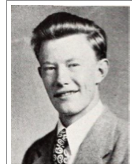 . Navy in the South Pacific. Upon completing his stint in the Navy he returned to Charlotte where he published a neighborhood weekly, The Grady Gazette. In 1950 Grady became a sports writer and columnist for the Charlotte News. In 1957 he took a position with the Philadelphia Daily News covering the Philadelphia professional teams, the Phillies and the Eagles. He also covered boxing including the career of Muhammad Ali. As a boxing writer he was named the winner of the A. J. Liebling Award for excellence in writing. Previous winners included W. C. Heinz and George Plimpton. Also, as a political writer Grady covered seven presidents and sixteen national conventions.
. Navy in the South Pacific. Upon completing his stint in the Navy he returned to Charlotte where he published a neighborhood weekly, The Grady Gazette. In 1950 Grady became a sports writer and columnist for the Charlotte News. In 1957 he took a position with the Philadelphia Daily News covering the Philadelphia professional teams, the Phillies and the Eagles. He also covered boxing including the career of Muhammad Ali. As a boxing writer he was named the winner of the A. J. Liebling Award for excellence in writing. Previous winners included W. C. Heinz and George Plimpton. Also, as a political writer Grady covered seven presidents and sixteen national conventions.
At the end of the 1945 school year, the Acorn included a salute to the graduates in the armed forces. It read, “To the hundreds of Harding boys and girls flung across the globe, The Acorn gives the ole ‘thumbs up’ sign and wishes them a safe return to the shores of Irwin Creek.” Unfortunately this wish was not to be realized by eleven graduates who lost their lives in service to their country.
The 1946 Acorn opened with a Dedication to these eleven young men. It read:
“We, the Class of 1946, dedicate this, our annual, to the Harding boys who lost their lives in the service of their country.
"They symbolize the essence of bravery for they have dared to die that freedom might live, and thrive, and multiply its blessings.
"Freedom is immortal and through it they are immortal in a way that humbles the enterprises of most men.”
These eleven were:
First Row Second Row
Class of 1939 – Eddie Black Class of 1943 – Bill Brookey
Class of 1942 – Bill Childress Class of 1941 – Neil Cline
Class of 1942 – Buck Greene Class of 1944 – Johnny Howell
Class of 1941 – Joe James Class of 1941 – Bill Knox
Third Row
Class of 1943 – Preston O’Quinn
Class of 1941 – J.C. Rhyne
Class of 1940 – Bryan Wollen
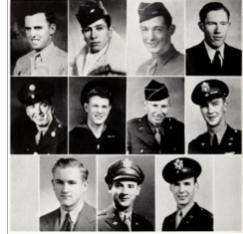
In the fall of 1945 two new English teachers joined the faculty, Vivian Johnson and Mary Fore. Miss Fore would eventually teach Senior English and held the keys to graduation since a requirement for graduating was a passing grade in Senior English. Many students were pulled from the rehearsal line due to a failing grade in her class.
Chapter 6 The Late Forties
With the addition of Edna Hartness and Floyd Bumgarner at the beginning of the 1946/1947 school year, the faculty of Harding had grown to thirty teachers. Mr. Bumgarner joined the coaching staff as the baseball coach and also coach of junior high sports.
Coach E. P. Faulkner organized an outstanding boxing team that included several young boys that would become champions in amateur and professional boxing. These included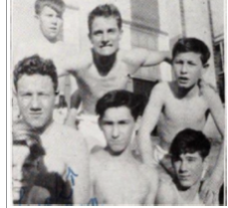 brothers Ronald Short and Billy Short. Both would later be inducted into the Carolinas Boxing Hall of Fame.
brothers Ronald Short and Billy Short. Both would later be inducted into the Carolinas Boxing Hall of Fame.
Billy was inducted in 1990. As an outstanding amateur boxer he fought twice at Madison Square Garden and reached the semifinals of the National Golden Gloves Tournament. He turned professional in 1952. As a professional he had fourteen fights. Of these he won eleven, lost only one, and had two draws. One of the draws was a ten rounder with Pappy Gault, who was the North American Featherweight Champion. Billy won his last six professional fights.
Ronald was inducted in 1992. As an amateur he won the Virginia-Carolina championship in 1948 and the Carolinas AAU Lightweight championship in 1951. He was crowned the Carolinas Golden Glove Lightweight Champion in both 1951 and 1953. During his amateur days he was dubbed the "Knock Out King." He had four professional bouts and won three of them, all by knockouts. Ronald and Billy both won professional bouts at a boxing event held at Griffith Park on September 9, 1954.
An outstanding athlete in the Class of 1947 was William A. “Pug” Pearman, a guard on the football team. In his senior year he was invited to play in the Shrine Bowl Game. His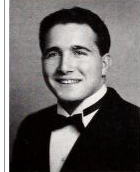 performance in that game resulted in his election to the Shrine Bowl All-time Team. After his senior year he was recruited by the University of Tennessee where he became a star lineman at the defensive tackle position. He played on the 1951 team that won the National Championship by beating Texas..\ Pearman was voted a first team All American defensive lineman, the first All American from Harding. He was also selected to participate in the College All-Star Game against the NFL champions. As a high school senior Pearman was not recruited by any college in North Carolina. This came back to haunt UNC Chapel Hill. They played Tennessee during the 1951 season and lost 27 to 0. As a result of his outstanding performance in the game, Pearman was named Defensive Player of the Week by the Associated Press.
performance in that game resulted in his election to the Shrine Bowl All-time Team. After his senior year he was recruited by the University of Tennessee where he became a star lineman at the defensive tackle position. He played on the 1951 team that won the National Championship by beating Texas..\ Pearman was voted a first team All American defensive lineman, the first All American from Harding. He was also selected to participate in the College All-Star Game against the NFL champions. As a high school senior Pearman was not recruited by any college in North Carolina. This came back to haunt UNC Chapel Hill. They played Tennessee during the 1951 season and lost 27 to 0. As a result of his outstanding performance in the game, Pearman was named Defensive Player of the Week by the Associated Press.
Special guests at the UNC/Tennessee game that year were the members of both of the teams that were participating in the ninth Ryder Cup golf match being held at Pinehurst, N. C. The Ryder Cup took Saturday off to allow the teams to attend the game. The U. S. team, which included Ben Hogan, Jimmy Demaret, and Sam Snead, beat the British by a score of 9.5 to 2.5.
The future of Harding football was changed significantly in the fall of 1947 with the addition of Dave Harris to the coaching staff. Harris was initially hired as an assistant coach but was moved to the head football coach the following year. With Harris as the head coach an era of twenty years of successful teams and players began.
Before becoming an outstanding football player for the Wake Forest Demon Deacons, 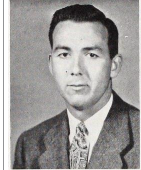 Harris won all state and all conference honors at Statesville High School. After high school he played right end for one year at Tennessee Military Institute. In 1942 Harris transferred to Appalachian State, again as a right end. In 1943 coach Peahead Walker recruited him to Wake Forest where he was named to the All-Southern Conference Team two consecutive years. In his senior year he was named to the first team of the All-American Blocking Team picked by Grantland Rice among others and was chosen to play in the East-West Shrine game held in San Francisco. After graduating from Wake Forest Harris played two years for the Charlotte Clippers professional football team.
Harris won all state and all conference honors at Statesville High School. After high school he played right end for one year at Tennessee Military Institute. In 1942 Harris transferred to Appalachian State, again as a right end. In 1943 coach Peahead Walker recruited him to Wake Forest where he was named to the All-Southern Conference Team two consecutive years. In his senior year he was named to the first team of the All-American Blocking Team picked by Grantland Rice among others and was chosen to play in the East-West Shrine game held in San Francisco. After graduating from Wake Forest Harris played two years for the Charlotte Clippers professional football team.
In 1941 the Clippers were awarded a franchise previously held by the Washington Presidents in the Dixie League. After a successful first season the League suspended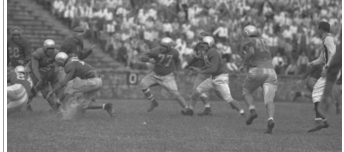 operation following the entry of the U. S. into World War II. After the war ended the League reorganized and in 1946, with Harris playing, the Clippers won the league title with a record of nine wins and only one loss. In 1947 the Staten Island Stapletons came to Charlotte to play the Clippers. The quarterback for the Stapletons, Bill Williams, was an African American. Thus, he became the first African American to play in an integrated major athletic contest in North Carolina. During the 1947 season three of the six teams withdrew and the league collapsed.
operation following the entry of the U. S. into World War II. After the war ended the League reorganized and in 1946, with Harris playing, the Clippers won the league title with a record of nine wins and only one loss. In 1947 the Staten Island Stapletons came to Charlotte to play the Clippers. The quarterback for the Stapletons, Bill Williams, was an African American. Thus, he became the first African American to play in an integrated major athletic contest in North Carolina. During the 1947 season three of the six teams withdrew and the league collapsed.
At Harding, Dave Harris began a rewarding career that included a streak of 35 straight games without a loss, winning two straight state championships. Over his twenty years at Harding eight of his players won High School All-American status and over seventy received full football scholarships. He was chosen to coach the 1956 North Carolina Shrine Bowl team and on two occasions was named North Carolina High School Football Coach of the Year.
After coaching at Harding he was named Athletic Director for the Charlotte-Mecklenburg School System. During his twenty-four years in that position he received many awards and honors, including being named Athletic Director of the Century by the North Carolina High School Athletic Association and being the first Charlottean inducted into the N. C. High School Athletic Association Hall of Fame. This award for athletic directors is named in his honor. In 1985 he was inducted into the Wake Forest Sports Hall of Fame.
In the fall of 1948 Dave Harris was the head football coach and the team responded with an outstanding season of 8 wins, 1 loss, and 2 ties during the regular season. One of the ties was with Central in a scoreless game that was played before 9,000 fans at Memorial Stadium. As a result of the tie, a playoff game was held to determine the winner of the City Championship with Central winning 7 to 0 and taking the title.
Throughout the season the Harding quarterback, Joe White, excelled in passing and punting and was selected to play in the Shrine Bowl game. His return for the 1949 season created an interesting dilemma for Coach Harris. Mt. Airy was on the 1949 schedule but refused to play the game if White participated claiming his was ineligible because of his participation in the Shrine Bowl the previous year. Harris held White out of the game and Harding lost.
After graduation, White was recruited by Wake Forest and in his senio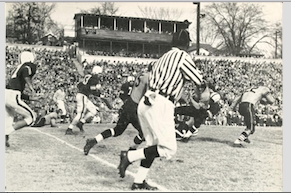 r year he lead the Deacons as the starting quarterback and punter. One of his best performances was against the University of South Carolina in a game played at Charlotte’s Memorial stadium on Thanksgiving day. South Carolina had only lost once coming into the game and Wake Forest had only won two games.
r year he lead the Deacons as the starting quarterback and punter. One of his best performances was against the University of South Carolina in a game played at Charlotte’s Memorial stadium on Thanksgiving day. South Carolina had only lost once coming into the game and Wake Forest had only won two games.
White completed twelve of fifteen passes, two of which went for touchdowns and Wake Forest won in an upset by the score of 19 to 13.
Harding had another successful team in the 1948/1949 school year. The girls basketball team captured the City Championship.
Turning from sports, a faculty change was introduced in 1948 with the naming of Mr. Creed Gilley to the position of Assistant Principal and Dean of Boys. Mrs. Mary Sawyer had been named Dean of Girls in 1941. So now, eight years later, the boys had a Dean.
Another change during the year was in the name of the school newspaper which dropped the name The Hustler and reverted to the earlier title of the Harding Hi-Lites.
With the start of the 1949/1950 school year. Harding was beginning its fifteenth year of operation. In 1935/1936 the faculty numbered fifteen, many of them coming from Central, AG, and Piedmont. They now had grown to a staff of forty-eight. Of these forty-eight, six were in the original faculty: Mr. J.R. Hawkins, Mrs. Willie Shore, Mrs. Lois Roach, Miss Sallie Sandifer, Miss Flora Mae Watson, and Mrs. Mary Sawyer. Over one thousand students now attended Harding.
For the 1949 football season, Harding was moved up to the AA classification which meant that schedules would be much tougher. This was reflected in a record of seven wins and five losses including a 20 to 14 heartbreaking loss to Central. Ray Morris, a transfer student from Lenoir, proved to be an outstanding runner for the Rams.
The basketball team had one of the best years in the school’s history, winning fourteen straight games before splitting two close contests with Central.
The members of Class of 1950 ended their high school careers in a traditional manner with the Junior/Senior Banquet held at the El Morocco Supper Club on Wilkinson Blvd.
Chapter 7 The Early Fifties
With the number one song "Goodnight Irene" by the Weavers stuck in their heads the students of the Class of 1951 entered Harding in September, 1950 along with three new teachers: Marian Bell, Alfred Strauss and William Mayberry.
Each year Harding selected a representative to ride in the Carolinas Carrousel parade.For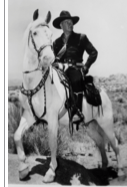 1950 the choice was Frances Miller. The Grand Marshall for the parade, one of the heroes for every boy at Harding when they were youngsters, William Boyd, better known as Hopalong Cassidy, rode his white horse Topper down Tryon Street. Boyd starred in 54 "Hoppy" movies and in 1950 appeared on the covers of both Time and Look magazines.
1950 the choice was Frances Miller. The Grand Marshall for the parade, one of the heroes for every boy at Harding when they were youngsters, William Boyd, better known as Hopalong Cassidy, rode his white horse Topper down Tryon Street. Boyd starred in 54 "Hoppy" movies and in 1950 appeared on the covers of both Time and Look magazines.
The parade, originally called the Charlotte Christmas Parade, was first held in 1947. The 1950 parade was the first to use the new name of "Carolinas Carrousel" and it drew the largest crowd in the history of the parade. The Carrousel was the fourth largest parade in the U.S.
In other activities three Harding students won the "Quiz Bangs" competition, which was similar to "Trivia" and the Senior Class performed the play Jane Eyre based on the novel by the appropriately named Charlotte Bronte.
The varsity football team had a disappointing season losing to Central by a score of 35 to 0 in a game played on Thanksgiving Day in Memorial Stadium. On a more positive note, the Junior High team won the City Championship, a good indicator of the football dynasty that would soon start building at Harding.
In the fall of 1951 Harding opened with a faculty of thirty-five including two new teachers, Mrs. Elizabeth Gore, a graduate of Catawba College, and William ‘Bud’ Jennings, a graduate of West Virginia University where he played football. Jennings was employed as an assistant coach and played a key role in aiding coach Dave Harris in building an outstanding football program. Before coming to Harding Jennings coached football and basketball at Oak Hill High School in West Virginia. In 1943 he was named as one of the top ten coaches of West Virginia colleges and high schools.
The football team had a much improved season winning seven games losing four and tying one. Harding still was winless in competition against cross-town rival Central as they lost 13 to 0. Pug Pearman, the school’s first All-American at Tennessee, appeared in the 1952 Acorn as a sponsor for the Monogram Club.
The high point of the year for the Class of 1952 was the Junior/Senior dance held at the Hotel Charlotte. Anxiety was usually high for the girls as the day of the dance approached. First, would they be asked to attend. Second, if asked should they delay accepting and wait for a better alternative, a risky decision. It was much easier for the boys, except in leap years when they faced the same decision. Usually they could just list their preferences first to last and then offer invites until one said yes. But 1952 was a leap year and the anxiety belonged to the boys. After the decision chess match of inviting and accepting was over, the measuring and the fitting began followed by the obligatory photos that would disappear into a seldom opened drawer that would some day be cleared out to make room for more.
With the arrival of fall in 1952 the expectations were high for the upcoming football season. The team responded with the best performance of any previous Harding team. The Rams won their first ten games by convincing scores and then faced Central whom they had 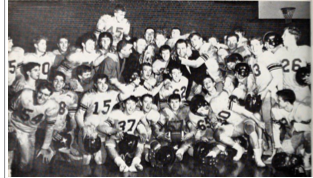 never defeated. After the game Coach Harris had the ride of his life as a jubilant team carried him off the sidelines onto the field of victory. With Doug Hinson’s two touchdowns they had beaten Central by a score of 14 to 13 and secured an undefeated season. Then it was on to the Western AA Championship game against Reidsville. A 13 to 7 win then launched them into Harding’s first State Championship contest. In the game they outclassed Henderson by the score of 32 to 13. The Harding Rams were the state champions.
never defeated. After the game Coach Harris had the ride of his life as a jubilant team carried him off the sidelines onto the field of victory. With Doug Hinson’s two touchdowns they had beaten Central by a score of 14 to 13 and secured an undefeated season. Then it was on to the Western AA Championship game against Reidsville. A 13 to 7 win then launched them into Harding’s first State Championship contest. In the game they outclassed Henderson by the score of 32 to 13. The Harding Rams were the state champions.
Five players from the team were selected for the All-City team: Roy Hord, Donnie Cates, Earl Todd, Bud Witherspoon, and Marion Justice. Roy Hord was also named to the All-State team and he and Doug Hinson were selected to play in the Shrine Bowl Game. Hord was recruited to play at Duke University where he was named first team All-American in 1957. He played on two Orange Bowl teams for Duke and was inducted into the Duke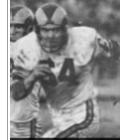 University Sports Hall of Fame in 2001. After college Hord entered the Army where he played football, baseball, and basketball for the U. S. Air Force team in Germany though he was in the Army. Before entering service he had been drafted by the Los Angeles Rams. He joined the team after his service obligation and started at right guard in his rookie season. He later played for the Philadelphia Eagles and the New York Jets. On October 23, 1961, Roy Hord became the first Harding graduate to have his picture on the cover of Sports Illustrated. After football, Hord became the General Manager of Riverside International Raceway in California.
University Sports Hall of Fame in 2001. After college Hord entered the Army where he played football, baseball, and basketball for the U. S. Air Force team in Germany though he was in the Army. Before entering service he had been drafted by the Los Angeles Rams. He joined the team after his service obligation and started at right guard in his rookie season. He later played for the Philadelphia Eagles and the New York Jets. On October 23, 1961, Roy Hord became the first Harding graduate to have his picture on the cover of Sports Illustrated. After football, Hord became the General Manager of Riverside International Raceway in California.
The Harding Rams continued their success in the fall of 1953, another season without a loss. The one smudge on their record was a tie with North Charleston. They beat Central for the second straight year to capture the City Championship along with the Western AA Region and the State Championships. Five of the players were selected to the All-City team; Boogie Smith, Eddie Moore. Donnie Cates, Louis Farmer, and Marion Justice. Justice was also placed on the All-State team.
The basketball team coached by Floyd Bumgarner also had a fine year winning fifteen games against only six losses.
Each year one of the school tasks requiring the most effort was the publication of the annual. This was certainly true for the 1954 Acorn. Sixty-five students, divided among the editorial, advertising, and circulation staffs, worked throughout the 1953/1954 school year to have the Acorn available for the classmates to scribble, “You are a nice person and I have enjoyed knowing you,” in each others annual.
The members of the advertising staff sold 144 ads to help defray the costs of publication. The ads were in the back of the annual where everyone wrote their good wishes. One of the advertisers in the 1954 Acorn was the Plantation Grill located on West Morehead Street. The ad read, “The Place for High School Students to Meet’. How true! In 1954 after a boy obtained a driver’s license, his primary goal since puberty, his first destination was the Plantation. It was a magical place where for $1.00 you got a hamburger, no onions please, with fries and a milkshake, including a generous tip for the curb hop, delivered right to your window. You could share the fries and shake then snuggle with your special one while listening to Dean Martin sing “That’s Amore.”
Having won the State Championship two years in a row, expectations were high again as a new season began in the fall of 1954. The team moved through the regular season winning every game until they faced Central. A hard fought contest ended in a 7 to 7 tie. The Rams again went to the Regional Championship game but lost to Reidsville. Thus ended a record-breaking streak of 35 consecutive games without a loss. For their last three games their helmets were painted with Ram’s horns. A change that later would be viewed as a bad luck omen.
Another Harding team had an even better record. When the girls basketball team lost to Myers Park in 1955, the defeat was their first loss in five years and ended a streak of 45 games without a loss.
In the fall of 1954 a World War II Marine war hero joined the Harding faculty as a history teacher. Douglas Crotts joined the Marine Corps on July 7, 1941, six months bef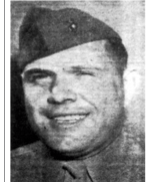 ore Pearl Harbor, and was assigned to C Company, 1st Corp Tank Battalion. On November 20, 1943, Crotts and the Tank Battalion came ashore on Tarawa, a Japanese stronghold in the middle of the Pacific Ocean where they faced almost 5,000 Japanese Marines that had built a defense consisting of a mass of cannons, reinforced concrete blockhouses and pillboxes, trenches with underground tunnels, anti tank pits, and barbed wire. In all there were over 500 reinforced, camouflaged positions on the one square mile island. Crotts and the other Marines had to wade through chin high water to reach the shore under constant fire. Of 14 tanks that were launched ashore only three were left in functioning condition. The next day Crotts mission was to walk unprotected in front of one of the remaining tanks to guide it toward the pillboxes and bunkers and to move injured or dead Marines out of the path of the tank. Seventy-six hours after the start of the invasion the Marines declared the battle of Tarawa over. This came after suffering 1,099 dead and 2,101 wounded. Crotts was awarded the Navy Cross and the British Distinguished Service Medal for his gallantry and heroism in the face of grave peril by defying intense machine gun and mortar fire from Japanese troops as he guided a tank to a location behind enemy lines. He did this while walking beside the tank to give directions by tapping on the tank with a metal casing. Later in the Pacific in Saipan he was again guiding a tank when he was shot through both legs by enemy fire. Crotts was awarded a Purple Heart for his wounds and a Bronze Star for his bravery and service to his comrades. (This information was provided by the research of Earl Gulledge, Harding High Class of 1963 and from a chapter devoted to Crotts in the book Eminent Charlotteans by Scott Syfert).
ore Pearl Harbor, and was assigned to C Company, 1st Corp Tank Battalion. On November 20, 1943, Crotts and the Tank Battalion came ashore on Tarawa, a Japanese stronghold in the middle of the Pacific Ocean where they faced almost 5,000 Japanese Marines that had built a defense consisting of a mass of cannons, reinforced concrete blockhouses and pillboxes, trenches with underground tunnels, anti tank pits, and barbed wire. In all there were over 500 reinforced, camouflaged positions on the one square mile island. Crotts and the other Marines had to wade through chin high water to reach the shore under constant fire. Of 14 tanks that were launched ashore only three were left in functioning condition. The next day Crotts mission was to walk unprotected in front of one of the remaining tanks to guide it toward the pillboxes and bunkers and to move injured or dead Marines out of the path of the tank. Seventy-six hours after the start of the invasion the Marines declared the battle of Tarawa over. This came after suffering 1,099 dead and 2,101 wounded. Crotts was awarded the Navy Cross and the British Distinguished Service Medal for his gallantry and heroism in the face of grave peril by defying intense machine gun and mortar fire from Japanese troops as he guided a tank to a location behind enemy lines. He did this while walking beside the tank to give directions by tapping on the tank with a metal casing. Later in the Pacific in Saipan he was again guiding a tank when he was shot through both legs by enemy fire. Crotts was awarded a Purple Heart for his wounds and a Bronze Star for his bravery and service to his comrades. (This information was provided by the research of Earl Gulledge, Harding High Class of 1963 and from a chapter devoted to Crotts in the book Eminent Charlotteans by Scott Syfert).
The 1955 basketball team lost their first three games, but rebounded to finish with a record of thirteen games won while losing eight. The team beat West in a playoff game that moved them into the Greater Charlotte AA Championship game where they avenged two earlier losses to Myers Park and won the Championship.
Chapter 8 The Mid Fifties
Prior to 1955 amusement rides and music were tame, TV was still finding its legs and teenagers who would become the Class of 1955 were falling to sleep listening to “Dream When You’re Feeling Blue” as Jimmy Kilgo signed off Kilgo’s Corner on WIST radio, 930 on the dial. The fabric of a teenage life was as smooth as silk, but it was soon to take on the texture of corduroy. It started in 1955 when teenagers all over the country were watching the movie “Black Board Jungle” and they heard Bill Haley and the Comets sing “Rock Around the Clock.” It continued with Little Richard, Chuck Berry, Jerry Lee Lewis, and others. Rock and Roll had arrived.
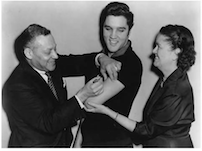
In 1956, Elvis Pressly burst onto the rock and roll scene. His rise in popularity was meteoric. In February he appeared at Charlotte’s Carolina Theater. Just six months later he performed at the Charlotte Coliseum to a sold out crowd of screaming teenagers. The January 25, 1957, edition of the Harding Hi-Lites even carried his picture on the front page of the school newspaper as he got his flu shot.
The Hi-Lites was a monthly publication that required six editors, about twenty reporters, a four person business staff, a large advertising staff and six typists. In addition to school news, the paper contained a What-Not column, RAM-blings, which covered sports, and a typical gossip column titled, Swing With a Heartbeat. Advertisers always included Parker-Gardner, Charlotte’s headquarters for music. Students could go to Parker-Gardner, put on headphones and play the latest hits in 78 rpm format or the new 45 rpm format.
The March 18, 1955, Hi-Lites carried an article that announced that Ned Gilliam had won a Morehead Scholarship, the most prestigious college scholarship in the state. Out of 450 high school boys that were nominated for the award, Ned was one of only 25 winners. He was Harding’s first recipient. The edition of the Hi-Lites also reported that the Rams boy’s basketball team won the Greater Charlotte AA championship and the girls team won their fifth straight city title.
During the summer vacation between school years, Mr. Hawkins managed the Municipal Swimming Pool and coaches Harris and Bumgarner ran the refreshment hut. Mr. Hawkins employed many Harding studen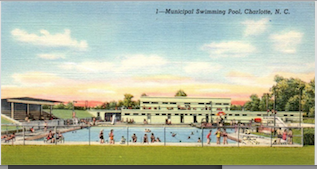 ts to work at the pool for the summer and gave them the elevated positions of lifeguard, locker boy, locker girl, and baby pool monitor. Across Barringer Drive from the pool was a miniature golf course, which was a precursor of the Putt-Putt courses that became popular later. The main difference was the almost impossible to avoid obstacles on the Putt-Putt courses, such as a rotating windmill that seemed to know exactly when one hit their putt. To get by it you had to have very precise timing or very good luck.
ts to work at the pool for the summer and gave them the elevated positions of lifeguard, locker boy, locker girl, and baby pool monitor. Across Barringer Drive from the pool was a miniature golf course, which was a precursor of the Putt-Putt courses that became popular later. The main difference was the almost impossible to avoid obstacles on the Putt-Putt courses, such as a rotating windmill that seemed to know exactly when one hit their putt. To get by it you had to have very precise timing or very good luck.
Chapter 9 The Late Fifties
When the 1955/1956 school year began, a new driver's training course was added to the curriculum with Mr. T. Alvin Corbett as the instructor. Also Mr. Thomas LaMarr Brigman joined the faulty as the new Art teacher. Mr. Brigman received his master’s degree in art education from the University of Georgia. He previously served as arts and crafts instructor at Camp Saranac in the Adirondacks in upper New York State. He was an accomplished artist, proficient in painting, sculpture, jewelry and textiles. His work was displayed in art exhibits throughout the southeast.
The 1955 football season had its ups and downs for Harding. The Rams beat a strong Asheboro team just as Charlotte News prognosticator Sad Sam predicted, but lost to Central in the final game of the regular season. The team won its initial playoff game but then lost to Hendersonville to complete a seven wins, five losses record. Bill Godfrey, George Hart, and Buzzy White were selected to the All-City team. George Hart, who excelled in football, basketball, and baseball, was chosen as Athlete of the Year for Mecklenburg County,
The basketball team won the Greater Charlotte AA championship with outstanding play by Jerry Hooper, who scored 50 points in a game against Gaffney. The Rams won the game by a score of 116 to 46. The score set a record, not only for the school, but also for the city. The game was part of a four game hot streak for the team when they averaged 103 points per contest. Two games scheduled against Ashley High of Gastonia were canceled by the Green Wave because someone painted the letters HHS in the Ashley school building.
The football season in the fall of 1956 was one of the most successful in the history of Harding. The team won five of their first six games of the season by shutting out their opponents. For those first six games the Rams scored a total of 211 points to only 8 for their opposition. Against West Mecklenburg fullback Bill Godfrey gained 172 yards and scored 3 touchdowns while carrying the ball only 4 times. Harding won all ten of their regular season games by a total score of 365 points to 28 for their opponents. In the final game of the regular season the Rams hammered Central 18 – 0 with the defense not allowing Central to advance the ball beyond their own 43 yard line. They then defeated Winston Salem Gray 52 to 12 in their initial playoff game before losing in the Western AA championship game to Canton.
Quarterback Jack Justice and fullback Bill Godfrey were selected to participate in the Shrine Bowl game, where Harding coach Dave Harris led the North Carolina squad to a 20 to 13 victory over South Carolina. Godfrey was also selected to play in the state’s East-West All-Star game where he scored the only touchdown of the contest. A further honor came to Godfrey when he was named honorable mention to the high school All American team.
After graduation, Bill Godfrey was recruited by the University of Georgia, where he became their starting fullback. In 1959 the Georgia Bulldogs upset the undefeated Alabama Crimson Tide by a score of 17 – 3. Godfrey had a forty-yard touchdown run in the game, the longest of the year for Georgia. The win carried Georgia into the Orange Bowl game.
Much was happening at Harding beyond the football field during the 1956/57 school year. The girl’s basketball team won the City Championship in spite of having to often practice at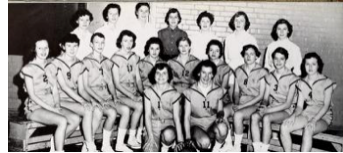 Garr Auditorium and Piedmont Jr. High. The championship was the ninth that Harding girls had won, a dominant record over the years that should have received much greater recognition. In boy’s basketball, radio station WSOC launched a Mecklenburg Player of the Week award and Harding’s Weldon Foard was the first recipient. The team also played Myers Park in a unique venue. It was the preliminary game to the Harlem Globetrotters vs. the Kentucky Colonel contest held at the Charlotte Coliseum.
Garr Auditorium and Piedmont Jr. High. The championship was the ninth that Harding girls had won, a dominant record over the years that should have received much greater recognition. In boy’s basketball, radio station WSOC launched a Mecklenburg Player of the Week award and Harding’s Weldon Foard was the first recipient. The team also played Myers Park in a unique venue. It was the preliminary game to the Harlem Globetrotters vs. the Kentucky Colonel contest held at the Charlotte Coliseum.
With the assistance of the Charlotte Kiwanis Club, Harding’s first Key Club was organized. Earlier, in February, 1955, the Student Council considered forming a Key Club. At the time proponents of the club stated, “A Key Club could sponsor many school activities which could aid in building up school spirit.” However, the Council voted against forming the club. When it was established in 1956 one of the first activities sponsored by the new club was renting buses for out of town football game trips, which contributed greatly to building school spirit for away games.
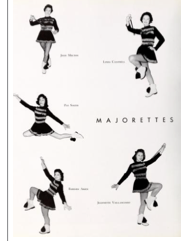
Another significant change at Harding was described in an article in the October 11, 1956 Hi-Lites. The article stated, “ Majorettes or no Majorettes? For years this has been a familiar question on the lips of our band members. In former years the question was always answered with the statement, ‘No majorettes!’ But 1956 is a new year and has brought a new answer. Harding now has five majorettes.” The new majorettes first appeared at an away game against Greenville Parker. In earlier years, Harding students started petition drives requesting majorettes, but they were always denied.
Since 1956 was a Presidential election year, Harding students held a mock election in which Dwight Eisenhower won with a total of 400 votes. Adlai Stephenson received 190 votes and Elvis collected 5.
As the end of the school year approached the members of the Class of 1957 were busy getting their new rings, signing annuals, Class Night, Maroon and Gold Day, getting their prom outfits for the Junior/Senior to be held at the Park Center, practicing for graduation, and, oh yes, studying for exams.
The students were looking forward to summer and the annual trip to Myrtle Beach where the girls would lie out in the sun, drenched in Coppertone, more for the aroma than protection. An aroma that was a magnet for attracting teenage boys who were either hanging around the Pavilion proving their expertise at the amusement machines or trolling the beach, not for fish. At night they would all gather around the jukebox at the out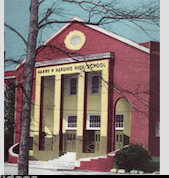 door dance floor to test their shag steps and hear "Sh Boom" played with every third dime inserted.
door dance floor to test their shag steps and hear "Sh Boom" played with every third dime inserted.
When the class of 1957 left Harding for the last time, as they walked up Irwin Avenue they could look back and see their class gift to the school, the name HARRY P. HARDING HIGH SCHOOL emblazoned across the entrance of the auditorium.
Three months later, on September 4, 1957, a new student saw the same scene as she stepped out of an automobile on Fifth Street and began her walk down Irwin Avenue to begin a new school year. She was quickly surrounded by a crowd of students. Dorothy Counts stood out from the others in the mob, a bit taller, better dressed, more poised, and she was black. She would be the first African American to enroll in Harding.
For many years at high schools across the south, a fuse had been burning and at the start of school in September, 1957, it had reached its combustion point. Segregated schools had long been the norm throughout the south. A Supreme Court ruling in 1896 had, in effect, sanctioned it by allowing segregated schools to continue so long as they were equal. In a landmark ruling in 1954, the Supreme Court declared that state laws establishing separate public schools for black and white students were unconstitutional. The ruling paved the way for integration.
On that September 4, 1957, students were expecting an attempt to integrate Harding, and they were ready to prevent it. A picture taken of the scene that day that appeared on the front page of newspapers across the country showed the crowd, mostly young boys, hurling racial slurs, abusive taunts, and some small objects at Dorothy Counts as she approached the school. The same menacing treatment continued throughout the succeeding days until her parents withdrew her from the school.
One of the young boys in the picture was Woody Cooper, Class of 1958. Approximately fifty years later Woody reached out to Dorothy to apologize for his behavior. In 1957, no one would sit at the lunch table with Dorothy, so, to right that wrong, Woody invited her to lunch. Over the succeeding months Woody and Dorothy became good friends. Woody passed away not too long afterwards and at his funeral service a tall, well dressed, poised, Africa American lady stood out among the mourners in the church. Dorothy Counts had come to honor the only person from the picture that ever reached out to her.
For all previous Harding graduates, the haunting question would be this; if we were there on September 4, 1957, would we have been in that picture?
Harding remained open as a combination high school/junior high school for four more years. At the beginning of the 1957/1958 school year the faculty had grown to 50 members and the senior class reached an all time high of 163 students. In its second year the Key Club grew to 24 members. Another record was set that year when Harding beat Central by a record margin of 26 points in a 39-13 victory, finishing with seven wins against only three losses. Two players, Ronald Hardman and Gary Whitley were awarded All-State honors.
At the end of the school year the Acorn was dedicated to the popular art teacher, T. Lamarr Brigman. Under his leadership some of the works of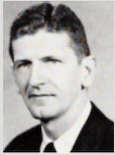 his students were included in an exhibit at the Museum of Modern Art in New York city. Mr. Brigman remained as the art instructor at Harding until 1967 when he assumed the same position at Olympic High where he taught for 21 more years.
his students were included in an exhibit at the Museum of Modern Art in New York city. Mr. Brigman remained as the art instructor at Harding until 1967 when he assumed the same position at Olympic High where he taught for 21 more years.
Of the 54 faculty members that began the 1958/1959 school year only seven had been on the original 1935 staff of sixteen. They were Mr. J. R. Hawkins. Miss Willie Shore, Mrs. Lois Roach, Miss Sarah Sandifer, Mrs. Lois Sumerville, Miss Flora Mae Watson, and Mrs. Mary Sawyer.
The dedication of the 1959 Acorn summed up the attributes of many of the outstanding teachers over the years at Harding. It read:
For the knowledge you have given to us;
For your constant understanding and guidance in the classroom;
For seeing us as individuals in the midst of the group;
For being our friend as well as our teacher;
For your gentle voice, your friendly smile, your loving heart;
For all these, the seniors, as a symbol of our love and gratitude
proudly dedicate this our 1959 Acorn to you.
The dedication was to Mrs. Vivian Rhodes.
The members of the Class of 1959 had been quite active in school activities and in sports. When they were ninth graders their Junior Honor Society sponsored the school's very first Junior High Homecoming. In sports the class of 1959 produced many outstanding athletes. These included Fred Stewart who led the city and the county in scoring on the basketball court, and Dwaine Godfrey and Jimmy King who received All-State honors for their performance on the football field. Godfrey was also named to the Shrine bowl team.
Chapter 10 The Closing Years
As the class of 1960 prepared their version of the Acorn they included a fitting memorial for the man who began their history and the history of all previous classes. Harry P. Harding passed away the previous summer and on its first page the annual was dedicated to his memory.
The 1960 Acorn, for the first time contained a few pictures in living color. Noticeably absent from the faculty pictures was that of Mrs. Roach, an original faculty member, who had retired at the end of the previous year. Another change reflected in the annual was the picture of the majorettes. They wore brand new uniforms, the first change from the original outfits introduced in 1957..png)
The football team had a signature win against North Mecklenburg by a score of 39-6. It was the 100th win for coach Dave Harris at Harding. Edward Aycoth, a member of the team received the first Charlotte Observer Sportsmanship Trophy. Edward was also president of the Student Council.
The 1960/61 school year brought more changes to the faculty. Two dedicated members of the original staff had passed away after the end of the previous year; Miss Sarah Sandifer was a beloved History Teacher and Guidance Counselor, and Mrs. Mary Sawyer had served as the school’s first Secretary and later as a Counselor and Dean of Girls. Also, Mrs. Harriett Stinson replaced longtime choir director Oliver Cook who had taken the position of Director of Music for Charlotte City Schools, and Mr. Bud Jennings replaced Mr. E. P. Faulkner as the basketball coach. Mrs. Willie Shore, another original faculty member retired in January of 1961.
Another change for the school was the structure of grades. Harding no longer had a seventh grade. These grades were placed at Spaugh Jr. High and Piedmont Jr. High. The changes were required due to the growth in the the higher grades. The original graduating class of 1938 had 36 seniors while the class of 1961 contained 195.
.png)
During the year there was a special ceremony for the installation of chaplains with Mrs. David Miller as guest speaker. Mrs. Miller was better known at Harding as Polly Jean Yandle, a graduate of the class of 1945. A few years after school, she and her husband went to serve as Presbyterian missionaries in the Belgium Congo. They, and their three children, were there when Belgium granted the Republic of the Congo their Independence. This created chaos and armed conflict as various factions battled for control of the new republic. The Miller family had to be taken out of the Congo by a helicopter of the Belgium government. Four months later the Republic of Congo central government under Patrice Lumumba regained control of the country and the Millers returned to serve for forty years as missionaries.
As the school year closed a special celebration was held to honor Mr. Hawkins for his 26 years as principal. Just as the first Acorn at the new school on Irwin Avenue was dedicated to Mr. Hawkins, so was the last. The dedication read:
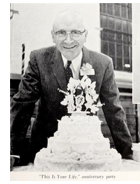
“More than any other person, Principal James R. Hawkins has been responsible for the growth of Harding High School. Since 1935, he has followed a blue print to see the building enlarged, the curricula expanded, the faculty increased, and the students placed in useful careers. For his conscientious and his constructive efforts, the students, past and present, are appreciative.
“It is with joy that the Seniors and the annual staff dedicate the 1961 Acorn to Mr Hawkins. May the dedication assure him of the devotion of all Harding students.”
The end of the school year of 1961 was also the end of Harding High School on Irwin Avenue. The fall of that year the school opened in a new campus on Alleghany St. The new school had grades nine through twelve, reflecting the new alignment of middle schools and high schools. Its name was eventually changed to “Harding University High School.” Mr. Hawkins continued as principal.
Epilogue
The facility that had served as Harry P. Harding High School for 26 years opened as a junior high school the fall of 1961. It later served as an elementary school, and then as a Head Start Center. In the late 1980s the school board decided to demolish the building except for the auditorium and the gym and build a structure that would better accommodate the Irwin Avenue Open Elementary School.
Three Harding graduates, Billy Parks, Earl Gulledge, and Sam Smith requested and received permission to remove any items from the structure to be demolished. They realized that little in the building dated back to the 30s, 40s, and 50s. However they were able to retrieve original locker number tags, which had been painted over many times. Slate blackboards from Miss Watson’s classroom that were well worn from the many theorems that had been chalked on them by nervous students were also salvaged. These were cut into tiles and sold as a fundraiser for the Harding Booster Club. Smith also removed the door from his senior year locker and used it to build a locker that he still retains as a lasting memory from the 1935 structure that Harry P. Harding built on the plot of land between Irwin Creek and Elmwood Cemetery.

